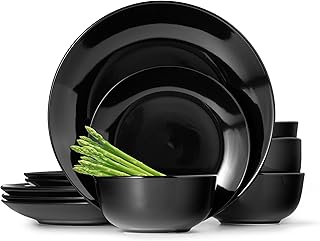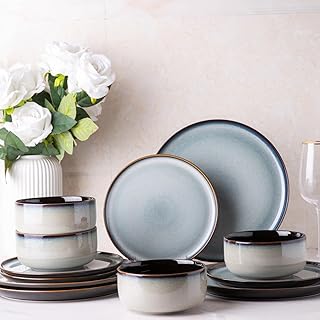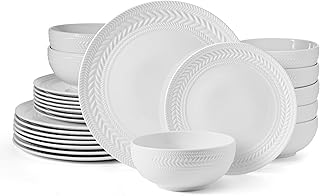












Category: porcelain dinnerware
Browse Our Porcelain Dinnerware Products
Our Porcelain dinnerware Products
What is the best way to care for my new porcelain dinnerware set?
To ensure the longevity and beauty of your porcelain dinnerware set, proper care and handling are essential. Avoid exposing your delicate pieces to extreme temperatures, as sudden changes can cause cracking or chipping. When washing your porcelain dinnerware, use a soft sponge and mild dish soap to avoid scratching the surface. A gentle cycle in the dishwasher is also acceptable, but be sure to check the manufacturer's guidelines first.To dry and store your porcelain dinnerware effectively, air-dry each piece thoroughly after washing to prevent water spots. Avoid stacking or nesting dishes on top of each other, as this can cause chipping or cracking. Instead, store each piece separately in a cupboard or on a shelf, using soft cloths or paper towels to protect the surfaces from scratches and dust accumulation. By following these simple care tips, you'll be able to enjoy your porcelain dinnerware set for many years to come.
Can I put my porcelain dinnerware in the dishwasher or should it be washed by hand?
When it comes to cleaning your porcelain dinnerware, it's essential to follow a few guidelines to ensure their longevity and prevent damage. While it may be tempting to toss them in the dishwasher for convenience, we recommend washing them by hand with mild soap and warm water instead.This is because high temperatures and harsh detergents found in dishwashers can cause porcelain to crack or become discolored over time. Additionally, the intense heat and movement of dishes during a cycle can also lead to chipping or scratching. By hand-washing your porcelain dinnerware, you'll be able to gently clean them without exposing them to these potentially damaging conditions.
How do I ensure my porcelain dinnerware is scratch and chip resistant?
To ensure your porcelain dinnerware is scratch and chip resistant, look for pieces made from high-quality materials and construction methods. High-fired porcelain, in particular, is more resistant to scratches and chips than lower-firing processes. Additionally, consider products with a glossy or matte glaze finish, as these can help protect the porcelain surface from wear and tear.When shopping for scratch and chip-resistant dinnerware, also pay attention to the thickness of the pieces. Thicker plates, bowls, and cups tend to be more durable than thinner ones. Furthermore, some manufacturers may use specialized techniques such as layering or infusing materials to enhance the overall durability of their porcelain products.
What are the benefits of using a 16-piece porcelain kitchen dinnerware set compared to smaller sets?
Using a 16-piece porcelain kitchen dinnerware set offers several benefits compared to smaller sets. Firstly, it provides a comprehensive collection of dishes for daily use, eliminating the need to constantly wash and store multiple pieces. This is particularly convenient in households with large families or frequent entertainers. A larger set also allows for more versatility in meal planning, as you can serve a wider variety of dishes without having to juggle multiple sets.A 16-piece porcelain kitchen dinnerware set typically includes an assortment of plates, bowls, cups, and utensils, which can be used for both formal and informal gatherings. This set provides ample options for serving breakfast, lunch, and dinner, as well as snacks and appetizers. Additionally, the larger quantity means you'll need to replace individual pieces less often, ultimately saving you money in the long run. The durability of porcelain also ensures that your dishes will withstand frequent use and washing, making a 16-piece set a worthwhile investment for any kitchen.
Are all porcelain dinnerware sets created equal?
Not all porcelain dinnerware sets are created equal. While they may share a common name and material, the quality, craftsmanship, and characteristics of these sets can vary significantly depending on factors such as manufacturer, design, and intended use.Porcelain dinnerware is often made from a type of ceramic material known for its whiteness, translucency, and strength. However, some sets may be mass-produced with lower-quality materials or less attention to detail, resulting in differences in durability, heat resistance, and aesthetic appeal. On the other hand, high-end porcelain dinnerware sets are often crafted with precision and care, featuring intricate designs, delicate patterns, and a more premium feel. When shopping for porcelain dinnerware, look for factors like manufacturer reputation, material quality, and craftsmanship to ensure you find a set that meets your needs and exceeds your expectations.
or does quality vary?
Quality can indeed vary within our porcelain dinnerware category, depending on several factors. Some differences in quality may stem from variations in craftsmanship, material selection, and manufacturing processes used by individual brands or artists featured on our site.For example, some pieces might be made with higher-grade ceramic materials, resulting in a more durable and less prone to chipping finish. On the other hand, others may utilize traditional techniques that can produce unique characteristics and imperfections, adding an element of handmade charm. By understanding these differences, customers can make informed purchasing decisions that suit their specific needs and preferences for quality, style, and value.
Can I mix and match different brands of porcelain dinnerware?
Mixing and matching different brands of porcelain dinnerware can be a great way to create a unique and personalized table setting. Porcelain dinnerware from various brands often share similar qualities such as durability, translucency, and chip-resistance, making it possible to combine pieces from different collections.When mixing brands, consider the style, color palette, and overall aesthetic you want to achieve. Look for cohesive elements like shared shapes, glaze colors, or decorative patterns that can tie together multiple brands' products. Some popular brands of porcelain dinnerware include Spode, Lenox, and Wedgwood, each offering a distinctive style that can complement other brands when mixed thoughtfully. By combining pieces from different brands, you can create a one-of-a-kind table setting that reflects your personal taste and adds visual interest to your dining experience.
or should I stick with one brand?
The age-old dilemma of whether to stick with one brand or explore different options! When it comes to porcelain dinnerware, having a single brand can be convenient and consistent in terms of quality, style, and price point. Many brands offer comprehensive collections that fit together beautifully, making it easy to build a cohesive table setting.However, sticking solely with one brand might limit your design possibilities and compromise on performance features. Exploring different options could expose you to unique characteristics, craftsmanship, and innovations from other manufacturers. Consider factors like durability, material quality, and design versatility when weighing the pros and cons of sticking with one brand versus venturing into new territory.
What is the typical price range for a high-quality porcelain dinnerware set?
The typical price range for a high-quality porcelain dinnerware set can vary depending on factors such as brand reputation, material quality, craftsmanship, and design complexity. Generally, you can expect to pay anywhere from $50 to $200 for a 4-piece setting (plates, bowls, cups) that is made with premium materials and has a classic or elegant design.If you're looking for more elaborate sets or those with intricate designs, patterns, or fine details, prices can range from $100 to $500 or even higher. Some high-end brands may offer sets with exceptional craftsmanship, unique designs, or rare materials, which can command prices upwards of $1,000. On the other hand, you can also find more affordable options that still offer good quality and value for around $20-$50 per piece. Ultimately, the price will depend on your personal preferences, budget, and standards for what constitutes "high-quality" dinnerware.


















































